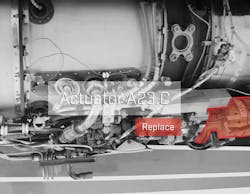Research shows that currently there are insignificant numbers of entrants from the military or trade schools getting into medium and heavy-duty truck maintenance positions, these are industry sectors in which a lot of existing GSE technicians began their careers. That factor, coupled with the fact that over the coming decade we will see a steady decrease in the numbers of experienced technicians in GSE workshops due to the retirement of Baby Boomers.
GSE maintenance managers that I know are either struggling to find “the right” candidates for vacant positions, or express concerns about the motivation and competency level of technicians they employ. Given the nature of our work environment, you don’t want to guess about a technician’s ability to manage a problem with a piece of ground support equipment on an active ramp.
The outlook seems bleak for GSE maintenance service providers and airlines alike. Traditional thinking and resulting efforts have produced negligible results. Furthermore, no one has come forward with a solution that can be employed across all maintenance related industry sectors.
Perhaps what’s required is some creative thinking for an innovative approach to cope with the Technician Challenge? Ruth Noller, a distinguished Professor of Creative Studies at Buffalo State College notes that practicing professionals often are seen as “having a great deal of knowledge and evaluative strength but as needing help with imagination."
"I believe that creative thinking and innovation and adaptation of existing technology will be essential to meeting the technician challenge,” Noller says.
Augmented Reality (AR) is a prime example. AR is the integration of digital information with live video and the user's environment in real time. Devices used for AR are commonly those of a computer, a camera, a processor and a screen. A great explanation of Augmented Reality (or AR) originates from the form Engine Creative “Put simply, AR is the term used to describe an enhanced view of real life by overlaying computer-generated content. This computer-generated ‘virtual content’ can be almost anything – video, 3D models, dynamic web content – and it can be triggered by an image, a location or a combination of the two.”
Perceived as the technology of the future, AR is making its way in the market place.
"I don’t see how modern fleets can avoid the use of this technology especially given the reduction of support for items such as training, part failure analysis, remote management, and the list just goes on,” Jimmy Mathis, director of global vehicles at FedEx Express, says from the maintenance perspective.
Imagine a time in the not-to-distant future where a newly hired technician is virtually connected to a seasoned technician.
Adapting and innovating AR to the airline industry sector, particularly GSE maintenance, may seem futuristic and far-fetched, however examples of AR hardware and interrelated software applications use for maintenance and service of vehicles can be seen today online; you can find demos of apps that act as a virtual instructor for everyday maintenance to vehicles on YouTube. For the benefit of the layperson, not only do apps track and virtually label the most important engine compartment components in real-time, they also include animated demonstrations of where you check the oil on the engine how to top up fluid levels. Some of these demonstrations even go as far as to display how AR provides instruction to mechanics for the dismantling and reassembly of components of the vehicle’s engine compartment in order to replace a part or complete a higher level of service to the vehicle.
If you think the cost of AR technology is beyond the reach of most organizations, think again. There are firms right now (some funded by a grants from defense agencies) that are developing the AR technology concept for the market place that runs on iPads, iPhone as well as an open-source head-mounted displays (HMD). This technology is available today and the costs are reasonable; I’m talking hundreds, not thousands of dollars for the HDM hardware.
It won’t take long for that technology to be further innovated for full-blown diagnosing and repairs. I envision numerous applications emerging from the steady development of ground-breaking AR for maintenance related industry sectors. This will transform the way technicians see, engage and learn from their surroundings. Perhaps it will even change the way a technician feels about his/her work; Studies show that this technology can increase engagement by merging task to media.
Augmented reality holds promising potential to quickly expand into all maintenance industry sectors. I can envision AR as a means to attract, teach, empower, motivate and even retain GSE technicians who would otherwise be considering retirement. Ideas have been suggested to me by industry colleagues/professionals on how to best achieve these goals once specialization of Augmented Reality to GSE maintenance occurs.
To inexperienced GSE technicians and their mangers, this technology is like having a genie in a bottle. And it also has the potential to revolutionize companies’ business models. One of the more ambitious concepts for adapting the technology details a plan for maintenance organizations to lower their operating costs, offers to extend the careers of a limited number of highly skilled and experienced technicians (that would otherwise be considering retirement), while also improving team [technician] efficiency, productivity and extent their impact in the workshop and on the ramp. With this scheme, as attrition of headcount occurs as a result of the Technicians Challenge, vacancies are filled by mostly entrants or “recycled” technicians at a substantially initial lower wage. A small number of semi-retired GSE Maintenance experts are employed at half-wage and full medical benefits to supplement the team. The experts can be made available on demand to act as virtual “tech support’, even from the comfort of porch swing. In effect, this creative approach allows an organization to maintain much of its bench strength even though “newbies” are filling its ranks. These experts will have the ability to virtually communicate to technicians who may otherwise struggle to diagnose and repairing ground support equipment. They can also help newbies better understand their surroundings while operating in an unfamiliar ramp environment.
Imagine the possibilities of these type resources existing in vehicle/GSE Maintenance. If developed to the full potential by using creative thinking this technology could completely change the face of GSE maintenance as we know it, allowing maintenance organization to thrive despite the Technician Challenge. All it will take is interest from major key players in the airline industry and innovation by some developers before AR technology in GSE maintenance can finally take off.
Given the nature of our work environment, you don’t want to guess about a technician’s ability to manage a problem with a piece of ground support equipment on an active ramp.
"I believe that creative thinking and innovation and adaptation of existing technology will be essential to meeting the technician challenge.” -Ruth Noller, professor, creative studies, Buffalo State College
I can envision AR as a means to attract, teach, empower, motivate and even retain GSE technicians who would otherwise be considering retirement.

